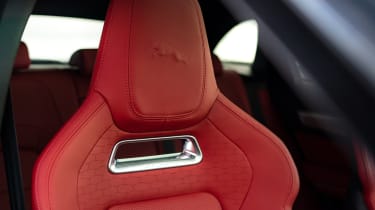Jaguar F-Pace review - Practicality, comfort and boot space
The F-Pace rivals cars like the Porsche Macan and BMW X3, but trumps them both for boot space and rear-seat practicality

The Jaguar F-Pace is aimed at a variety of SUV buyers and hopes to steal sales from a range of rivals. These include the BMW X3 and Audi Q5, as well as larger models like the X5 and Q7.
There’s only one body style, but if you want something a bit smaller and more manageable, there's always the E-Pace. The all-electric I-Pace slots between these two, but has a bit more space inside than the F-Pace.
Back to the F-Pace, and there’s plenty of room up front and loads of adjustment for the seats and steering wheel. Considering its almost coupe-like proportions, space in the back isn’t bad either, and if you avoid the full-length panoramic roof that restricts headroom then you’ll be able to seat six-foot adults in the rear.
Size
The Jaguar F-Pace is 4,747mm in length, which makes it longer than an Audi Q5, although slimmer and stubbier than a Q7. There’s much more room inside than you’ll find in a Porsche Macan, and it very nearly matches models like the more expensive Cayenne for outright carrying capacity.
Leg room, head room & passenger space
The Jaguar F-Pace is an extremely comfortable car to drive. It seems perfectly suited to all types of road – munching motorways, A-roads and urban environments with ease. The seats are supportive and there’s loads of adjustment to allow even the fussiest drivers to get set behind the wheel.
In the back, there’s loads of leg and knee room, and – providing you avoid the full-length panoramic roof – there’s enough headroom for even taller adults. Despite the narrow windows there’s plenty of light, and because you sit low in the car the coupe-style roofline doesn’t affect headroom too much. This means that even tall adults will be comfortable. Where a Porsche Macan feels rather claustrophobic, the F-Pace exudes a sense of spaciousness that isn’t usually possible on cars with such stylish sloping rooflines.
Used - available now

2022 Kia
Sorento
37,674 milesAutomaticPetrol1.6L
Cash £26,700
2022 Toyota
Corolla
23,108 milesAutomaticPetrol1.8L
Cash £16,500
2022 Mercedes
CLA
73,131 milesAutomaticPetrol1.3L
Cash £20,100
2020 Hyundai
Kona Electric
41,990 milesAutomaticElectric
Cash £12,200Access is good, too, thanks to doors that open wide – meaning fitting an Isofix child seat in the rear is all too easy. The seats fold 40:20:40, allowing a myriad seating combinations depending on who or what you’re carrying.
Boot
The F-Pace is impressively packaged. As well as being big enough to carry five six-foot adults, you’ll also find a decent 613 litres of boot space with the rear seats in place. This expands to 1,440 litres when the 40:20:40 split rear seats are folded flat.
However those figures don't apply to the plug-in hybrid F-Pace, because its batteries are housed underneath the boot floor. As a result, you only have 485 litres to work with when the rear seats are in place. Folding the rear seats down gives you 1,299 litres to work with.
More problems arise when you want to slide in big, mucky loads for the tip. Beautiful details like the brushed metal boot lip are just asking to be scratched, while the plush leather seats aren’t likely to look as fresh in 60,000 miles time. There are various tie-down points and nets though, meaning it’s fairly easy to secure loose loads.
Towing
The maximum braked trailer towing capacity for the Jaguar F-Pace is 2,400kg, with the exception of the P400e plug-in hybrid version which has a 2,000kg rating.









